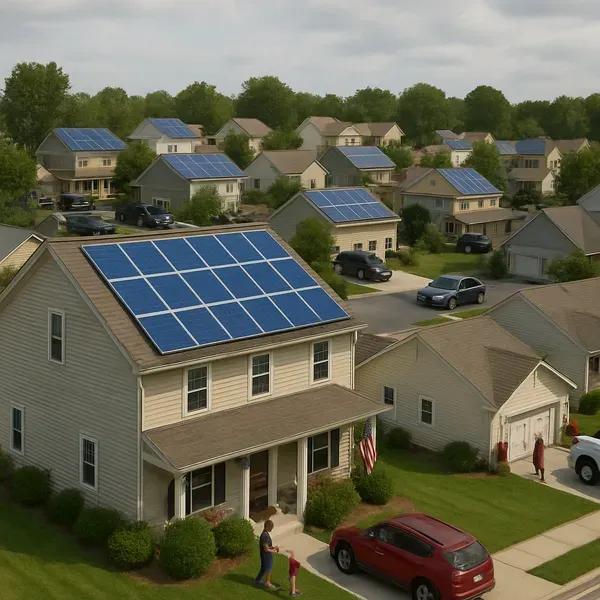Solar Power Without the Price Tag? Your Comprehensive Guide to Solar PPAs
The allure of solar energy is undeniable. Lower electricity bills, reduced carbon footprints, and greater energy independence are compelling benefits. However, the significant upfront cost of purchasing and installing a solar panel system remains a major hurdle for many homeowners, businesses, and organizations. Fortunately, alternative pathways exist to access clean solar power without breaking the bank.
One of the most popular is the Solar Power Purchase Agreement, or PPA. This guide provides a clear, balanced overview of PPAs, helping potential users understand how they work, weigh the pros and cons, and determine if this model is the right fit.
What Exactly is a Solar PPA?
At its core, a Solar Power Purchase Agreement (PPA) is a financial arrangement, not just an energy contract. Under a PPA, a third-party entity – often called a solar developer or solar services provider – handles the entire process of bringing solar energy to a customer's property. This includes designing the system, obtaining permits, financing the project, installing the solar panels (typically on a rooftop or adjacent land), and then owning, operating, and maintaining the system throughout the agreement's duration.
The customer, or "host," agrees to allow the system on their property and commits to purchasing the electricity generated by that specific solar system. This power is sold at a predetermined rate, usually expressed in cents per kilowatt-hour (kWh), for a specified contract term. Essentially, the host buys the service – the solar electricity produced – rather than the physical solar equipment itself.
This structure cleverly separates the burdens of system ownership, capital investment, and operational risk (which remain with the developer) from the benefits of consuming clean, often cheaper, solar energy (which accrue to the customer). It functions as a financial tool enabling solar access, particularly because the developer can leverage financial incentives like federal tax credits (e.g., the Investment Tax Credit or ITC) and potentially state incentives or Solar Renewable Energy Credits (SRECs) to lower their overall project costs. These financial benefits, which the host customer does not receive directly under a PPA , are factored into the developer's calculations, allowing them to offer the host a competitive PPA electricity rate.
Why Consider a PPA? The Major Benefits
The popularity of PPAs stems from several key advantages they offer to customers:
- No or Low Upfront Cost: This is arguably the most significant draw. The developer shoulders the substantial initial investment required for system design, equipment purchase, and installation. This eliminates the primary financial barrier for many potential solar adopters, allowing them to start benefiting from solar energy almost immediately upon system activation.
- Potential Electricity Cost Savings: PPA contracts typically offer an electricity rate per kWh that is lower than the prevailing retail rate charged by the local utility company. This can translate into immediate and ongoing savings on monthly energy bills, often estimated between 10% and 30%.
- Predictable Energy Pricing: PPAs provide long-term certainty regarding the cost of solar electricity. By locking in a rate (or a predefined escalation schedule) for 15-25 years, customers gain budget stability and a valuable hedge against the often unpredictable and rising costs of traditional grid electricity. While some PPAs have fixed rates throughout the term, many include annual price escalators, which will be discussed later.
- No Maintenance Responsibility: Since the developer owns the solar system, they are responsible for its ongoing operation, monitoring, maintenance, and any necessary repairs throughout the life of the PPA contract. This effectively transfers the system performance risk and operational burden away from the host customer.
- Environmental Commitment: Utilizing solar power through a PPA allows homeowners and organizations to visibly demonstrate their commitment to sustainability and reducing their environmental impact by using clean, renewable energy.

What Are the Catches? Potential Downsides and Risks
Despite the compelling benefits, PPAs involve trade-offs and potential drawbacks that require careful consideration:
- Long Contract Terms: PPAs represent a significant, legally binding commitment, typically spanning 15 to 25 years. This long duration necessitates careful thought about long-term property plans and potential life changes. Entering such a lengthy agreement should not be taken lightly.
- Price Escalators: Many, though not all, PPA contracts include an annual price escalator clause. This means the price paid per kWh increases by a predetermined percentage each year, often between 1% and 5% (commonly cited rates are 2-5%). While often designed to be lower than projected utility rate hikes, there's a risk: if utility rates stagnate or rise slower than the PPA escalator, the initial savings could diminish or even disappear over the contract term. Fixed-rate PPAs avoid this risk but might start with a slightly higher initial kWh price.
- Property Sale Complications: Selling a property with an active PPA can introduce complexities. Typically, the homeowner must either transfer the PPA contract to the new buyer – who must meet the PPA provider's credit requirements and agree to assume the contract terms – or buy out the remainder of the contract, which can be expensive. This process can be more cumbersome than selling a home with a fully owned solar system.
- No Ownership Benefits: It's crucial to understand that under a PPA, the customer does not own the solar panel system. Consequently, they are not eligible for the federal solar tax credit, state or local tax incentives, or any income generated from selling Solar Renewable Energy Credits (SRECs) associated with the system's production. These financial benefits accrue entirely to the system owner (the developer or third-party financier).
- Potential Site Upgrade Costs: While the developer covers the solar system installation, the PPA contract might stipulate that the property owner is responsible for certain prerequisite site upgrades. This could include necessary roof repairs or trimming trees that shade the proposed solar array location.
- Early Termination Fees: Exiting a PPA contract before its scheduled end date usually incurs substantial early termination fees (ETFs). These fees can be significant, reflecting the developer's need to recoup their investment and lost future revenue.
Know Before You Sign: Key PPA Contract Terms
Given the long-term nature and financial implications of a PPA, thoroughly understanding the contract is paramount. Key terms to scrutinize include:
- Contract Duration: The specific length of the agreement, typically 15, 20, or 25 years.
- Price per kWh & Escalation Rate: The starting price for solar electricity and, critically, the details of any annual price escalator (e.g., a fixed percentage increase like 2.9% per year, or a fixed rate for the entire term).
- System Performance Guarantees: Clauses outlining the expected annual energy production of the system. Some contracts may include provisions for compensation (e.g., bill credits) if the system consistently underperforms these guarantees, aligning the provider's incentive with the customer's outcome.
- Maintenance and Repair Responsibilities: Explicit confirmation that the PPA provider is responsible for all system monitoring, maintenance, and repairs.
- End-of-Contract Options: Clear articulation of the choices available when the PPA term expires. Common options include renewing the PPA, purchasing the solar system from the developer (often at its Fair Market Value or a predetermined price), or having the developer remove the system at no cost to the host.
PPA vs. Buying vs. Leasing: How Do They Compare?
PPAs are one of several ways to go solar. Understanding the alternatives – primarily direct ownership (via cash purchase or loan) and solar leases – helps clarify the PPA's position.
- Direct Ownership: Involves purchasing the system outright or financing it with a solar loan. This requires a significant upfront investment or managing loan payments. However, the owner receives all financial benefits, including the federal tax credit, state/local incentives, and potentially SREC income. The owner is also responsible for all system maintenance after warranties expire. Ownership generally offers the highest potential long-term return on investment.
- Solar Lease: Structurally similar to a PPA in that a third party owns and maintains the system, requiring little to no upfront cost from the customer. The key difference lies in the payment structure: a lease typically involves a fixed monthly payment for the use of the system, regardless of how much electricity it produces that month. This offers greater budget predictability compared to a PPA's variable monthly bill, which fluctuates with solar production.
- Solar PPA: As detailed above, involves no/low upfront cost, third-party ownership and maintenance, and payments based on the actual amount of electricity (kWh) generated each month. The developer receives the tax credits and other incentives.
The following table summarizes the core differences:
How Do You Get a PPA? The Typical Process
Engaging in a PPA generally follows these steps:
- Consultation & Site Assessment: Initial discussions with PPA providers to evaluate energy needs and assess property suitability (roof condition, orientation, shading, available space).
- Proposal & Contract Negotiation: Reviewing detailed proposals outlining system size, projected production, PPA rate, escalator (if any), and all contract terms. Careful negotiation and understanding are vital.
- System Design, Permitting & Installation: Once the contract is signed, the developer manages the system design, secures necessary permits, and installs the solar panels.
- Interconnection: The developer coordinates with the local utility to connect the system to the grid.
- System Activation & Operation: Following successful commissioning and interconnection, the system begins generating power, and the PPA billing commences based on measured output. The entire process from contract signing to operation typically takes three to six months.
Who Are PPAs Best For?
PPAs can be an excellent fit for a wide range of customers, including homeowners, businesses, schools, universities, government agencies, non-profits, and houses of worship. They are particularly well-suited for those who:
- Want to go solar but lack the upfront capital or borrowing capacity for direct purchase.
- Have sufficient electricity consumption to make the savings meaningful.
- Possess a suitable property with adequate unshaded space (roof or ground).
- Meet the PPA provider's creditworthiness requirements.
- Are located in a state or jurisdiction where third-party ownership of energy generation (the legal basis for PPAs) is permitted. The availability of PPAs is dependent on these regulations.
- Want to take advantage of their state's net metering program
- Are tax-exempt entities (like schools, municipalities, or non-profits) that cannot directly utilize federal or state tax incentives. PPAs allow these organizations to benefit indirectly from those incentives through a lower PPA electricity price offered by the developer who can monetize them.
A Quick Look at PPA Variations
While this guide focuses on the standard on-site PPA, it's worth noting related concepts exist:
- Community Solar PPAs: Allow customers to subscribe to a portion of a larger, offsite solar farm and receive bill credits, without installing anything on their property.
- Virtual PPAs (VPPAs): Primarily financial contracts used by large organizations to support renewable energy development and make environmental claims, often without direct physical power delivery from the specific project.
- Offsite PPAs: Similar to VPPAs but may involve physical delivery arrangements from a remote solar facility.
Conclusion
Solar Power Purchase Agreements offer a compelling pathway to adopting solar energy, removing the significant barrier of upfront costs and shifting the responsibilities of system maintenance and operation to a third party. They provide access to potentially lower, more predictable electricity costs and allow customers to leverage clean energy immediately.
However, the benefits come with important trade-offs. PPAs involve long-term contractual commitments, potential price escalators that need careful evaluation, and complexities related to property sales. Furthermore, customers forego the direct financial incentives associated with system ownership. Before entering into a PPA, it is crucial for potential hosts to meticulously evaluate their energy needs, financial situation, long-term property plans, and critically, to thoroughly review and understand every clause within the PPA contract, paying close attention to pricing, escalators, performance guarantees, and end-of-term options. A PPA can be an excellent tool, but informed diligence is key to ensuring it aligns with specific goals and circumstances.
